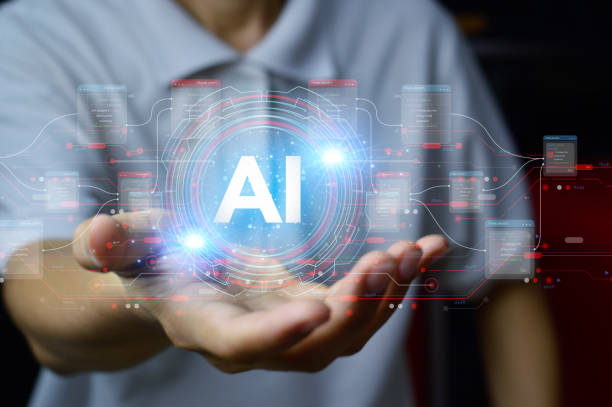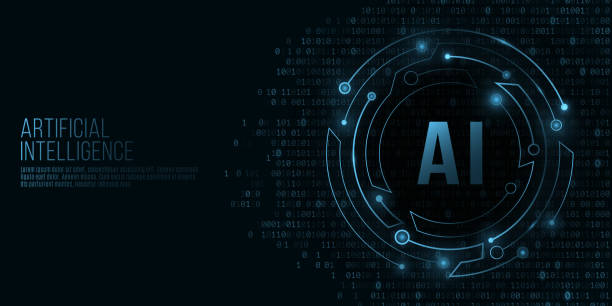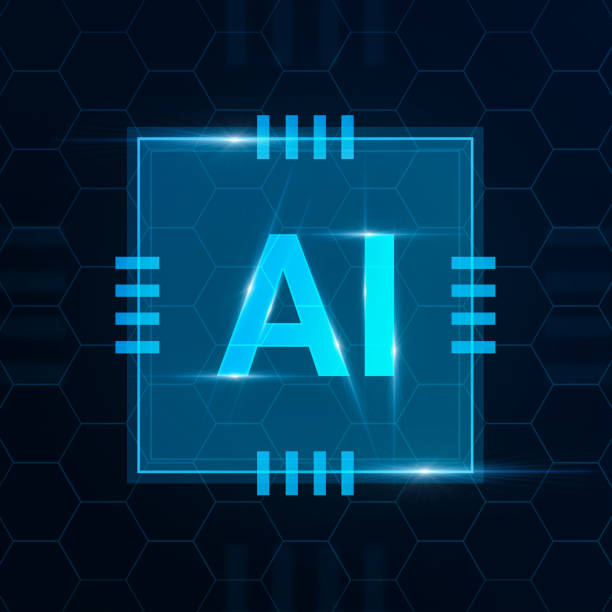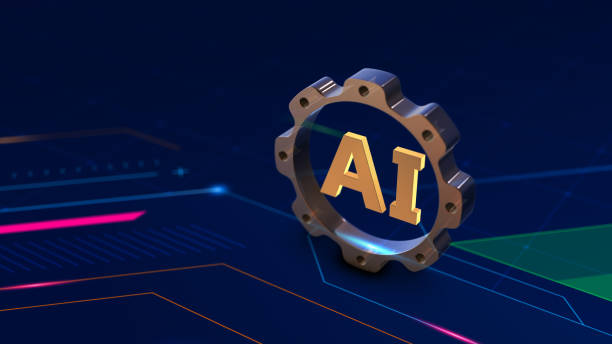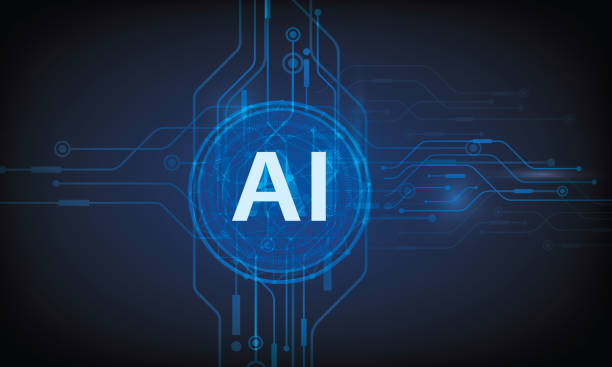What is Artificial Intelligence? Definition and Basic Concept
Artificial Intelligence (AI), or #Artificial_Intelligence (AI), in short, refers to the ability of a machine or computer system to perform tasks that typically require human intelligence.
These tasks can include learning, reasoning, problem-solving, natural language understanding, pattern recognition, and decision-making.
Artificial intelligence is a broad and multidisciplinary field that draws on various sciences such as computer science, mathematics, statistics, psychology, and philosophy.
The main goal of #Artificial_Intelligence is to create machines that can perform complex tasks automatically and without human intervention.
The concept of artificial intelligence dates back to ancient times, but significant advances in recent decades have made it one of the most important and widely used technologies of the present era.
In fact, artificial intelligence tries to simulate human thinking processes and implement them in the form of algorithms and computer models.
These processes can include learning from data, extracting patterns, predicting events, and making optimal decisions.
Using artificial intelligence, the efficiency and accuracy of many systems and processes can be improved, and it becomes possible to perform tasks that were previously impossible or very difficult.
#Artificial_Intelligence has extensive applications in various fields such as medicine, industry, transportation, finance, and education, and is constantly being developed and advanced.
Are you unhappy with the low conversion rate of visitors to customers on your online store?
Solve this problem forever with a professional online store design by Rasaweb!
✅ Increase visitor-to-customer conversion rate
✅ Create a great user experience and build customer trust
⚡ Get free consultation
Types of Artificial Intelligence Approaches and Classifications
Artificial intelligence can be categorized based on various criteria.
One of the most common classifications is based on the capabilities and features of #Artificial_Intelligence.
Based on this, artificial intelligence can be divided into two main categories:
Weak Artificial Intelligence (Narrow AI): This type of artificial intelligence is designed to perform specific and limited tasks.
Facial recognition systems, voice assistants such as Siri and Alexa, and movie and music recommendation systems are examples of weak artificial intelligence.
These systems perform very well in their tasks, but are unable to perform other tasks.
Strong Artificial Intelligence (General AI): This type of artificial intelligence has cognitive abilities similar to humans and can perform any task that a human can.
Strong artificial intelligence is still in the early stages of development, and no strong artificial intelligence system has been built so far.
The development of strong artificial intelligence poses many technical and ethical challenges.
In addition, artificial intelligence can also be categorized based on the approaches used.
Some of the common approaches in artificial intelligence include:
Machine Learning: In this approach, machines learn using data and improve their performance without the need for explicit programming. Deep Learning: This approach is a subset of machine learning that uses artificial neural networks with multiple layers to learn complex patterns from data. Natural Language Processing: This approach allows machines to understand and interact with human language. Computer Vision: This approach allows machines to understand and analyze images and videos. Artificial intelligence is rapidly evolving, and new approaches and techniques are constantly being developed.
Widespread Applications of Artificial Intelligence in Various Industries
#Artificial_Intelligence is increasingly used in various industries and has a significant impact on how things are done.
Below are some of the applications of #Artificial_Intelligence in various industries:
Medicine and Healthcare: #Artificial_Intelligence is used in diagnosing diseases, developing drugs, personalizing treatments, managing hospitals, and providing remote healthcare services.
Artificial intelligence systems can analyze medical images with high accuracy and diagnose diseases in their early stages.
Also, artificial intelligence can play an effective role in developing new drugs and optimizing drug dosages.
Industry and Manufacturing: Artificial intelligence is used in automating production processes, quality control, predicting equipment failure, optimizing the supply chain, and managing warehouses.
Intelligent robots can perform repetitive and dangerous tasks and increase productivity.
Also, artificial intelligence can predict equipment failure by analyzing sensor data and prevent production downtime.
Finance and Banking: #Artificial_Intelligence is used in fraud detection, risk assessment, investment management, customer service, and automating banking processes.
Artificial intelligence systems can identify suspicious patterns in financial transactions and prevent fraud.
Also, artificial intelligence can identify investment opportunities by analyzing market data and provide financial advice to customers.
Transportation: Artificial intelligence is used in the development of self-driving cars, optimizing routes, managing traffic, and providing smart transportation services.
Self-driving cars can drive without the need for a human driver using sensors and artificial intelligence algorithms.
Also, artificial intelligence can analyze traffic data and suggest optimal routes to reduce traffic and air pollution.
Education: Artificial intelligence is used in personalizing education, providing automated feedback, developing educational content, and managing classrooms.
Artificial intelligence systems can analyze student performance, identify their strengths and weaknesses, and provide appropriate educational content.
Machine Learning and its Role in the Advancement of Artificial Intelligence
Machine Learning is one of the most important subfields of #Artificial_Intelligence, which plays a fundamental role in the advancement of this field.
In machine learning, machines learn using data and improve their performance without the need for explicit programming.
This approach allows machines to identify complex patterns and relationships in data and use them for prediction, decision-making, and problem-solving.
Click here to preview your posts with PRO themes ››
Machine learning is divided into three main categories:
Supervised Learning: In this type of learning, the machine learns using labeled data.
Labeled data includes the desired inputs and outputs.
By analyzing this data, the machine tries to create a learning model that can predict the correct outputs for new inputs.
Unsupervised Learning: In this type of learning, the machine learns using unlabeled data.
The machine tries to identify hidden patterns and structures in the data.
Clustering and Dimensionality Reduction are examples of unsupervised learning methods.
Reinforcement Learning: In this type of learning, the machine learns by interacting with its environment.
The machine receives rewards or penalties for taking different actions.
The machine’s goal is to learn a strategy that maximizes rewards over time.
Machine learning is used in a wide range of applications, including facial recognition, fraud detection, movie and music recommendation, and self-driving cars.
Recent advances in Deep Learning, a subset of machine learning that uses artificial neural networks with multiple layers, have led to significant improvements in the performance of artificial intelligence systems in many areas.
Machine learning is recognized as one of the main drivers of innovation and progress in #Artificial_Intelligence.
Did you know that 85% of customers check your company’s website before any interaction?
With Rasaweb, build a company website that deserves your reputation.
✅ Increase credibility and customer trust
✅ Attract high-quality leads
⚡ Get a free website design consultation
Natural Language Processing A Bridge Between Humans and Machines
Natural Language Processing (NLP) is an important field of #Artificial_Intelligence that allows machines to understand and interact with human language.
The main goal of NLP is to create systems that can analyze, translate, summarize, respond to, and generate human text and speech.
NLP uses various methods such as machine learning, deep learning, and linguistic rules to perform these tasks.
Some of the common applications of NLP include:
Machine Translation: Machine translation systems can translate text from one language to another.
By analyzing the structure and meaning of the text, these systems try to provide an accurate and fluent translation.
Sentiment Analysis: Sentiment analysis systems can identify emotions and opinions in text.
These systems can be used to analyze customer opinions, monitor social networks, and evaluate feedback.
Text Summarization: Text summarization systems can turn a long text into a short and useful summary.
These systems can be used to summarize articles, reports, and news.
Question Answering: Question answering systems can answer questions asked in natural language.
By searching in knowledge bases and analyzing text, these systems can find appropriate answers.
Voice Assistants: Voice assistants like Siri and Alexa use NLP to understand voice commands and answer user questions.
NLP plays an important role in facilitating communication between humans and machines and makes it possible for non-specialists to use computer systems in various fields.
Recent advances in deep learning have led to significant improvements in the performance of NLP systems in many areas.
Natural Language Processing is a key area of #Artificial_Intelligence that is rapidly developing and advancing.
Computer Vision A New View of the World of Images
Computer Vision is another important area of #Artificial_Intelligence that allows machines to understand and analyze images and videos.
The main goal of computer vision is to create systems that can extract useful information from images and videos and use them to perform various tasks.
Computer vision uses various methods such as machine learning, deep learning, and image processing to perform these tasks.
Some of the common applications of computer vision include:
Facial Recognition: Facial recognition systems can identify people’s faces in images and videos.
These systems can be used for access control, security, and marketing.
Object Detection: Object detection systems can identify different objects in images and videos.
These systems can be used for industrial automation, self-driving cars, and video surveillance.
Motion Detection: Motion detection systems can identify the movement of people and objects in videos.
These systems can be used for security, surveillance, and sports analysis.
Medical Image Analysis: Medical image analysis systems can analyze radiology, MRI, and CT Scan images and help doctors diagnose diseases.
Self-Driving Cars: Computer vision plays a fundamental role in the development of self-driving cars.
Self-driving cars use computer vision to understand their surroundings and decide how to drive.
Computer vision enables the automation of many tasks and can play an effective role in improving the efficiency and accuracy of many systems.
Recent advances in deep learning have led to significant improvements in the performance of computer vision systems in many areas.
Computer Vision is a key area of #Artificial_Intelligence that is rapidly developing and advancing and helps artificial intelligence increase the efficiency and accuracy of systems.
Click here to preview your posts with PRO themes ››
Current Challenges and Limitations of Artificial Intelligence
Despite significant advances in #Artificial_Intelligence, this field still faces numerous challenges and limitations.
Some of these challenges include:
Need for Big Data: Many #Artificial_Intelligence systems, especially machine learning-based systems, require large amounts of data for training.
Collecting and processing this data can be costly and time-consuming.
Interpretability Problem: Some artificial intelligence systems, especially deep learning-based systems, act as black boxes.
Understanding how these systems make decisions is difficult, which can reduce trust in them.
Sensitivity to Biased Data: If the training data of #Artificial_Intelligence systems is biased, the system may also make biased decisions.
This can lead to discrimination and inequality.
Ethical Issues: The development and use of #Artificial_Intelligence raises numerous ethical issues.
For example, the use of #Artificial_Intelligence in autonomous weapons and widespread surveillance can have dire consequences.
Computational Limitations: Training and running some #Artificial_Intelligence models requires a lot of computing resources.
This can hinder the development and use of these models on a large scale.
Attackability: Artificial intelligence systems are very vulnerable to cyber attacks, and it is possible to manipulate their inputs and outputs.
Overcoming these challenges and limitations requires more research and development in various areas of #Artificial_Intelligence.
Also, attention to ethical and social issues when developing and using #Artificial_Intelligence is of great importance.
“`
th, td {
border: 1px solid black;
padding: 8px;
text-align: left;
}
“`
th {
background-color: #f2f2f2;
}
“`
“`html
| Challenge | Description |
|---|---|
| Need for Big Data | Artificial intelligence systems need a large amount of data for training. |
| Interpretability Problem | Understanding how some artificial intelligence systems make decisions is difficult. |
| Sensitivity to Biased Data | If the training data is biased, the system may also make biased decisions. |
| Ethical Issues | The development and use of artificial intelligence raises numerous ethical issues. |
“`
The Future of Artificial Intelligence and its Impact on Human
Life
#Artificial_Intelligence is rapidly advancing and is expected to have a
significant impact on human life in the near future.
Some predictions about the future of #Artificial_Intelligence
include:
Extensive Automation: Artificial intelligence can automate many
repetitive and routine tasks, which leads to increased productivity and
reduced costs.
This can have a significant impact on the labor market and requires the
retraining of the workforce.
More Personalization: Artificial intelligence can personalize
services and products based on individual needs and preferences.
This can lead to improved user experience and increased customer
satisfaction.
Better Decision-Making: Artificial intelligence can make better
decisions in various fields by analyzing large data.
This can lead to improved organizational performance and reduced
risks.
Treatment of Diseases: Artificial intelligence can play an
effective role in diagnosing diseases, developing drugs, and personalizing
treatments.
This can lead to improved human health and increased lifespan.
Space Travel: Using artificial intelligence, robots can be designed
to travel at high speed to distant points and bring valuable findings to humans
with correct scientific and accurate decisions.
However, the development and use of artificial intelligence requires
attention to ethical and social issues.
It is necessary to ensure that #Artificial_Intelligence is used for the
benefit of all members of society and to prevent discrimination and
inequality.
The future of artificial
intelligence is bright and promising, but requires careful planning and
management.
Are you disappointed with the low conversion rate of your online store?
Rasaweb with professional online store design is your definitive
solution!
Increase your sales and revenue
Unparalleled user experience for your customers
Get a free consultation right now!
Artificial Intelligence and New Job Opportunities
#Artificial_Intelligence Development and expansion have created new job
opportunities in various fields.
Some of the professions related to #Artificial_Intelligence
include:
Machine Learning Engineer: These people are responsible for
designing, developing, and training machine learning models.
Data Scientist: These people are responsible for collecting,
analyzing, and interpreting data.
Natural Language Processing Engineer: These people are responsible
for developing systems that can understand and interact with human
language.
Computer Vision Engineer: These people are responsible for
developing systems that can understand and analyze images and
videos.
Artificial Intelligence Ethics Specialist: These people are
responsible for ensuring the ethical use of
#Artificial_Intelligence.
To enter these jobs, it is necessary to have a relevant degree in the
fields of computer science, mathematics, statistics, and engineering.
Also, having programming, data analysis, and machine learning skills is of
great importance.
Job opportunities in the field of #Artificial_Intelligence are growing
rapidly, and it is expected that demand for #Artificial_Intelligence
specialists will increase in the coming years.
By acquiring the necessary skills, you can achieve great success in this
booming field.
#Artificial_Intelligence is a dynamic and
evolving field.
“`
th, td {
border: 1px solid black;
padding: 8px;
text-align: left;
}
“`
th {
background-color: #f2f2f2;
}
“`
“`html
| Job Title | Description |
|---|---|
| Machine Learning Engineer | Design and develop machine learning models |
| Data Scientist | Collect, analyze and interpret data |
| Natural Language Processing Engineer | Develop systems that understand human language |
| Artificial Intelligence Ethics Specialist | Ensure the ethical use of artificial intelligence |
Click here to preview your posts with PRO themes ››
“`
Learning Resources for Artificial Intelligence
For learning #Artificial_Intelligence, various resources are available.
Some of these resources include:
Online Courses: Websites Coursera, edX, and Udacity offer numerous
online courses in the field of
#Artificial_Intelligence.
Books: There are many books in the field of
#Artificial_Intelligence that can help you learn basic and advanced
concepts.
Scientific Articles: By reading scientific articles, you can stay
informed of the latest advances in the field of
#Artificial_Intelligence.
Practical Projects: By doing practical projects, you can strengthen
your skills in the field of #Artificial_Intelligence.
Online Community: By joining #Artificial_Intelligence online
communities, you can connect with other enthusiasts in this field and use
their experiences.
For example, Python is a programming
language.
To start learning #Artificial_Intelligence, you can start by studying
basic concepts and doing simple projects.
Then, you can gradually move on to more advanced concepts and more complex
projects.
With perseverance and continuous effort, you can achieve great success in
this booming field.
#Artificial_Intelligence is a world of endless
learning and innovation.
Frequently Asked Questions
“`html
| Question | Answer |
|---|---|
| 1. What is Artificial Intelligence (AI)? |
It is a branch of computer science that aims to create machines capable of simulating human intelligence and performing tasks that require human thinking, such as learning, problem-solving, and decision-making. |
| 2. What are the main types of artificial intelligence? |
It can be classified into weak artificial intelligence (Narrow AI) that focuses on a specific task, general artificial intelligence (General AI) that has comprehensive human capabilities, and super artificial intelligence (Super AI) that exceeds human intelligence. |
| 3. Mention some common applications of artificial intelligence in our daily lives. |
These include voice assistants (such as Siri and Alexa), recommendation systems (such as Netflix and Amazon), self-driving cars, facial recognition systems, and spam filters. |
| 4. What is the difference between artificial intelligence and machine learning (Machine Learning)? |
Artificial intelligence is the broader concept of creating intelligent machines, while machine learning is a subset of artificial intelligence that focuses on enabling systems to learn from data without explicit programming. |
| 5. What is Deep Learning? |
It is a subset of machine learning that uses multi-layered artificial neural networks (deep neural networks) to process data and discover complex patterns, and is used in image and speech recognition. |
| 6. What are the most prominent benefits of artificial intelligence? |
Improving efficiency and productivity, automating repetitive tasks, making better decisions based on big data analysis, and developing solutions to complex problems in areas such as medicine and science. |
| 7. What are the main challenges facing the development and deployment of artificial intelligence? |
These include the need for vast amounts of high-quality data, privacy and security issues, bias in data and algorithms, and high development and maintenance costs. |
| 8. Does artificial intelligence raise ethical or social concerns? |
Yes, it raises concerns related to privacy, algorithmic bias, job loss due to automation, and responsibility for errors made by intelligent systems, and the need for a regulatory framework. |
| 9. How can artificial intelligence affect the future of the labor market? |
It can lead to the automation of some routine tasks, but it will also create new jobs that require advanced skills in developing, operating, and maintaining artificial intelligence systems. |
| 10. What are some of the modern or promising technologies in the field of artificial intelligence? |
These include advanced natural language processing (NLP) (such as large language models such as ChatGPT), computer vision, robotics, and generative AI (Generative AI). |
“`
Other services of Rasa Web advertising agency in the field of advertising
Smart SEO: A new service to increase online growth by optimizing key pages.
Smart UI/UX: A combination of creativity and technology to improve SEO
ranking through custom programming.
Smart Data Analysis: A creative platform to improve user interaction with
custom programming.
Smart Marketing Automation: An effective tool to increase site traffic by
using real data.
Smart Brand Identity: A professional solution for digital branding with a
focus on optimizing key pages.
And more than hundreds of other services in the field of internet
advertising, advertising consulting and organizational solutions
Internet Advertising | Advertising Strategy | Advertorial
To boost your business in the digital space, Rasa Web Digital Marketing
Agency is with you. By using the latest online marketing methods, from SEO
and content production to website design with a modern user interface, we
offer comprehensive and result-oriented solutions to be seen more and attract
loyal customers. Let our expertise pave the way for your digital success and
comprehensively fulfill your goals.
📍 Tehran, Mirdamad Street, next to the Central Bank, South Kazerun Alley,
Ramin Alley No. 6
✉️ info@idiads.com
📱 09124438174
📱 09390858526
📞 02126406207
Sources
What are the applications of artificial intelligence?
What is Artificial Intelligence (AI)? From A to Z
What is Artificial Intelligence (AI)? Introduction, History and Applications
What is Artificial Intelligence and what are its applications?




